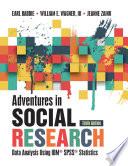
Adventures in Social Research
Data Analysis Using IBM SPSS Statistics
Proud sponsor of the 2019 SAGE Keith Roberts Teaching Innovations Award—enabling graduate students and early career faculty to attend the annual ASA pre-conference teaching and learning workshop. Recipient of the 2018 Cornerstone Author Award! Inspire students to pursue their own adventures in social research with this practical, hands-on introduction to data conceptualization, measurement, and association through active learning. Adventures in Social Research: Data Analysis Using IBM® SPSS® Statistics offers a practical, hands-on introduction to the logic of social science research for students in many disciplines. The fully revised Tenth Edition offers step-by-step instruction on data analysis using the latest version (24.0) of SPSS and current data from the General Social Survey. Organized to parallel most introductory research methods texts, this text starts with an introduction to computerized data analysis and the social research process, then takes readers step-by-step through univariate, bivariate, and multivariate analysis using SPSS Statistics. The range of topics, from beginning to advanced, make Adventures in Social Research appropriate for both undergraduate and graduate courses. For students who are using SPSS for the first time, the free online study site includes video tutorials on basic procedures and operations and includes all SPSS data sets necessary for completing the exercises in the book. Available with Perusall—an eBook that makes it easier to prepare for class Perusall is an award-winning eBook platform featuring social annotation tools that allow students and instructors to collaboratively mark up and discuss their SAGE textbook. Backed by research and supported by technological innovations developed at Harvard University, this process of learning through collaborative annotation keeps your students engaged and makes teaching easier and more effective. Learn more.
- ISBN 13 : 1506362753
- ISBN 10 : 9781506362755
- Judul : Adventures in Social Research
- Sub Judul : Data Analysis Using IBM SPSS Statistics
- Pengarang : Earl Babbie, William E. Wagner, III, Jeanne Zaino, William E. Wagner, III, Jeanne Zaino,
- Kategori : Social Science
- Penerbit : Sage Publications
- Bahasa : en
- Tahun : 2018
- Halaman : 512
- Google Book : https://play.google.com/store/books/details?id=NtE_DwAAQBAJ&source=gbs_api
-
Ketersediaan :
008049 Tersedia di Library of UI BBC
Organized to parallel most introductory research methods texts, this text starts with an introduction to computerized data analysis and the social research process, then takes readers step-by-step through univariate, bivariate, and ...









